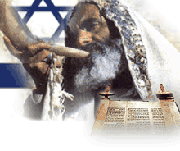Rosh Hashanah - Jewish New Year

Feast of the Trumpets remembers world's creation
by David Johnson
 Rosh Hashanah begins September 13, 2015 Related Links | ||||||||||
Rosh Hashanah Dates
| ||||||||||
On Sunday night, Oct. 2, 2016, Jews will begin celebrating one of their most important religious holidays, Rosh Hashanah. It remembers the creation of the world. In Hebrew, Rosh Hashanah means the "head of the year." It is also called the Feast of the Trumpets. The blowing of a ram's horn, a shofar, proclaims Rosh Hashanah, and summons Jews to religious services.
Jews used the ram's horn as a trumpet in Biblical times to announce the new moon, holidays, and war. Today, a variety of horns are used, including curved antelope horns.
Putting your spiritual house in order
While it does have its festive side, Rosh Hashanah is not one big party, as the New Year's celebrations on Dec. 31 tend to be. Rosh Hashanah is a time for personal introspection and prayer.
Jews may also visit graves. It is thought that the prayers or good wishes of the dead can help the living. By wishing each other well and sending cards, people let friends know what happened in the past year and what plans lie ahead. Christmas cards and get-togethers fill a similar role for Christians.
Rosh Hashanah is part of a process of spiritual growth. The Hebrew month preceding it, Elul, is a time for charity, tzedakah. Rosh Hashanah falls on the first and second days of the seventh month, Tishri.
Food for thought
Traditional Jewish foods accompany Rosh Hashanah. Typically, a blessing will be said over two loaves of bread, known as challah. The round shape symbolizes a crown, a reminder of the kingship of God. Challah also stands for the circle of life, and the hope that our lives endure without end.
Challah is sometimes baked with a ladder on top in recognition that only God decides who climbs up or down the ladder of life. Forming challah in the shape of a bird is also done. The Torah says that God will protect Jerusalem in the same way a bird hovers.
Apples dipped in honey are another Rosh Hashanah tradition. It symbolizes the hope for a "sweet year" ahead. Honey is spread on challah. Tzimmes, a mixture made from carrots, cinnamon, yams, prunes, and honey, is also traditional.
Sephardic Jews—those of Mediterranean or Middle Eastern origin—serve a whole fish as a wish for prosperity, fertility, and good luck for the coming year. Some Jews also present fruit baskets covered to hide the contents, symbolizing that no one can know what the new year will bring.
Determined by the new moon
Rosh Hashanah observances vary. Orthodox Jews celebrate Rosh Hashanah for two days. Reform Jews often observe it for only one day. In Biblical times the moon, not the calendar, determined dates for festivals. Witnesses watching the sky proclaimed the new moon. Since Rosh Hashanah falls on the first day of the month, people living far from Jerusalem did not have time to learn the exact date. Even those living near Jerusalem could miss the festival if the witnesses did not arrive on time. So, two days were set aside for observance so everyone would have time to participate.
